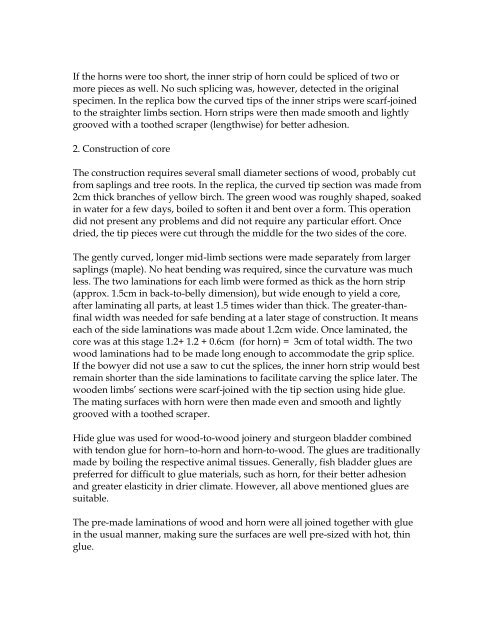You also want an ePaper? Increase the reach of your titles
YUMPU automatically turns print PDFs into web optimized ePapers that Google loves.
If the horns were too short, the inner strip of horn could be spliced of two or<br />
more pieces as well. No such splicing was, however, detected in the original<br />
specimen. In the replica bow the curved tips of the inner strips were scarf-joined<br />
to the straighter limbs section. Horn strips were then made smooth and lightly<br />
grooved with a toothed scraper (lengthwise) for better adhesion.<br />
2. Construction of core<br />
The construction requires several small diameter sections of wood, probably cut<br />
from saplings and tree roots. In the replica, the curved tip section was made from<br />
2cm thick branches of yellow birch. The green wood was roughly shaped, soaked<br />
in water for a few days, boiled to soften it and bent over a form. This operation<br />
did not present any problems and did not require any particular effort. Once<br />
dried, the tip pieces were cut through the middle for the two sides of the core.<br />
The gently curved, longer mid-limb sections were made separately from larger<br />
saplings (maple). No heat bending was required, since the curvature was much<br />
less. The two laminations for each limb were formed as thick as the horn strip<br />
(approx. 1.5cm in back-to-belly dimension), but wide enough to yield a core,<br />
after laminating all parts, at least 1.5 times wider than thick. The greater-thanfinal<br />
width was needed for safe bending at a later stage of construction. It means<br />
each of the side laminations was made about 1.2cm wide. Once laminated, the<br />
core was at this stage 1.2+ 1.2 + 0.6cm (for horn) = 3cm of total width. The two<br />
wood laminations had to be made long enough to accommodate the grip splice.<br />
If the bowyer did not use a saw to cut the splices, the inner horn strip would best<br />
remain shorter than the side laminations to facilitate carving the splice later. The<br />
wooden limbs‟ sections were scarf-joined with the tip section using hide glue.<br />
The mating surfaces with horn were then made even and smooth and lightly<br />
grooved with a toothed scraper.<br />
Hide glue was used for wood-to-wood joinery and sturgeon bladder combined<br />
with tendon glue for horn–to-horn and horn-to-wood. The glues are traditionally<br />
made by boiling the respective animal tissues. Generally, fish bladder glues are<br />
preferred for difficult to glue materials, such as horn, for their better adhesion<br />
and greater elasticity in drier climate. However, all above mentioned glues are<br />
suitable.<br />
The pre-made laminations of wood and horn were all joined together with glue<br />
in the usual manner, making sure the surfaces are well pre-sized with hot, thin<br />
glue.


